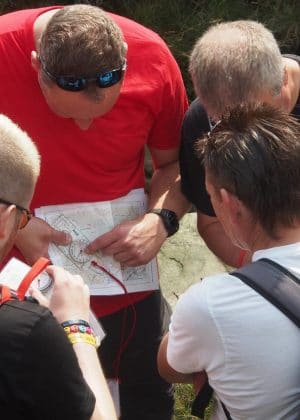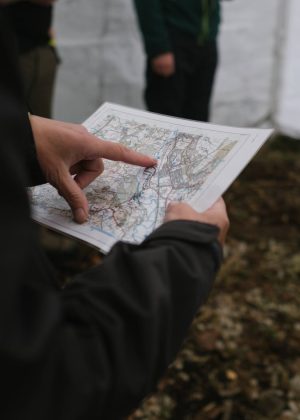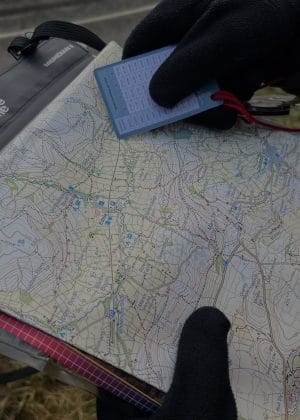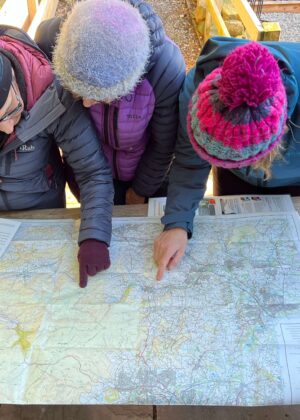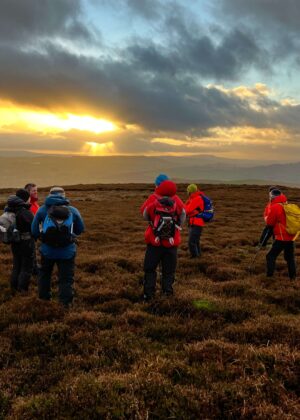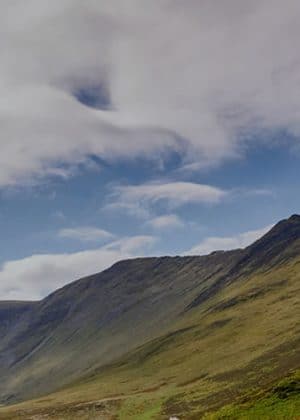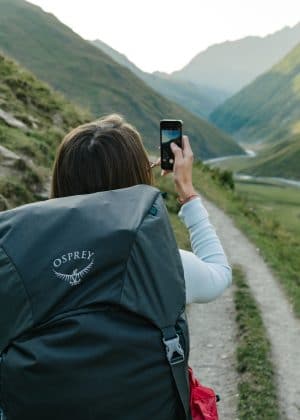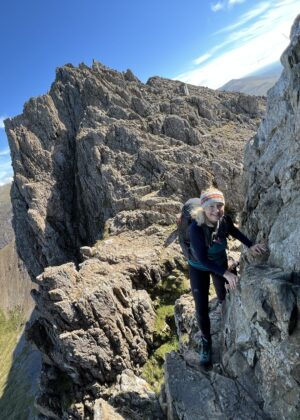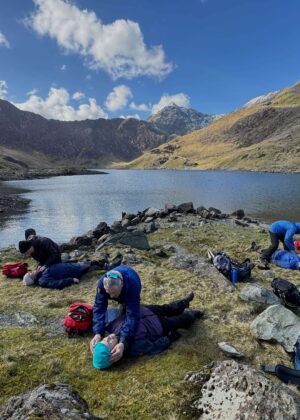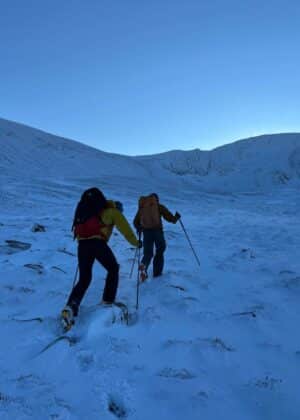- Level 3 Award in Outdoor First Aid
- Learn how to deal with emergencies in the outdoors
- Friendly, relaxed courses taught by outdoor professionals
- Active learning rather than boredom by PowerPoint!
Our comprehensive two-day (16 hour) outdoor first aid qualification will provide you with the skills and knowledge to respond to a range of emergency outdoor situations. Based in Eryri (Snowdonia), North Wales, you’ll learn about when and how to move a casualty, how to deal with major illnesses and injuries, administering CPR and managing someone who is unresponsive.
The course is perfect for anyone spending time in the outdoors whether you’re a keen hillwalker or outdoor professional. If you find yourself in an environment where emergency medical assistance could be more than 30 minutes away, these outdoor first aid skills are essential.
Courses are delivered in a friendly, relaxed manner by experienced outdoor professionals. We keep medical jargon to a minimum with the focus being on practical, active learning. We believe the best way to learn is by ‘doing’ and not by sitting in a classroom with a notebook listening to someone talk at you. Where weather conditions allow, much of the course is taught in the outdoors … exactly where you’d expect to use your new found skills.
The qualification meets the Outdoor First Aid Band 3 requirements set by the Institute for Outdoor Learning and is ideal for those with outdoor instructor qualifications such as Mountain Leader, Rock Climbing Instructor, Paddlesports Instructor, etc. It’s also essential learning for Scout and Guide Leaders, DofE instructors and assessors, forest school leaders and many more.
Your course fee includes a high quality, comprehensive outdoor first aid book, a CPR keyring face shield and a casualty report form for you to copy and use as you wish.
Over the two days, we’ll cover a range of outdoor first aid topics including:
- Resuscitation
- Casualty monitoring
- Primary survey/secondary assessment
- Incident management
- Scene survey
- Summoning assistance
- First aid equipment
- Bones, joints and muscle injuries
- Major illnesses
- Burns
- Wounds and bleeding
- Catastrophic bleeding control NEW!
- Extreme heat and cold
- Respiratory disorders
- Poisoning
- Head and spinal injuries
- Anaphylaxis
- Eye injuries
- Hypovolaemic shock
- Bites and stings
- Chest and abdominal injuries
 Spread your payments with Klarna. Book now and pay in 30 days or pay in 3 instalments over the next 3 months.
Spread your payments with Klarna. Book now and pay in 30 days or pay in 3 instalments over the next 3 months.
For example, choose to pay the £125 as 3 monthly instalments of around £42. Klarna is safe and secure and payments are interest-free.
Click to Pay in 3 with Klarna
(this link will allow one person to book a single place on the next available Outdoor First Aid course. If you want to book for more than one person or for a different date, please contact us and we'll send you a bespoke payment link)
- Level - EASY
- Duration - 2 days (16 hours)
- Group - Up to 12
- Age - 18+
-
Price - £125 (+ £12 course fee)
or pay in 3 instalments of £46 interest-free with Klarna

What people say about this activity











Frequently Asked Questions
In addition to this two-day outdoor first aid course, we also offer a shorter, one-day ’emergency outdoor first aid’ option. This covers the essentials for those who are time short or whose qualifications only requires an 8 hour outdoor first aid course. It’s essentially just the first day of the two-day course.
This longer, two-day course covers much more and is the usual course for those spending time in the outdoors.
Our outdoor first aid course is aimed at anyone who spends time in the outdoors. You might be an occasional hill walker or a mountain professional; if you enjoy being out in the countryside then this course is ideal for you.
The course takes place over 16 hours over two consecutive days and you’ll need to attend both days to be eligible for the qualification. We usually start at 9am and aim to finish around 5pm each day (with a little bit of homework in between!)
We’re proud to offer some of the best value outdoor courses in the UK. Our two-day Level 3 Outdoor First Aid Qualification costs £125 for adults (aged 18+). Successful candidates will receive a digital certificate at the end of the course.
You can either choose to pay in full when you book online or if you book by phone you can avoid the online booking fees imposed by our booking provider.
If you’d like to spread your payments with Klarna, you can book now and pay in 30 days or pay in 3 instalments over the next 3 months. For example you can choose to pay the £125 as 3 monthly instalments of around £42. Klarna is safe and secure and payments are interest-free.
Great question. Yes it does!
Each course attendee will receive their own 133 page book containing comprehensive guidance on outdoor first aid. This high quality publication is easy to read, fully illustrated and up-to-date and perfectly complements your outdoor first aid course.
Our outdoor first aid courses take place at Boulder Adventures in Llanberis. Located in the heart of the village, we have use of a spacious classroom as well as large gardens and outdoor area.
There’s no need to worry about the assessment. Whilst you will need to meet certain criteria set out by the awarding body, you’ll have the two days to prove yourself. The assessment takes place throughout the course rather than as an ‘exam’ on the last day.
Yes of course! Unlike many providers offering first aid courses, we only deliver genuine, regulated qualifications.
Our Level 3 Outdoor First Aid qualification is regulated in the UK and awarded by First Aid Awards (FAA). FAA is an awarding organisation regulated by Ofqual and SQA Accreditation and the qualification sits on the Regulated Qualifications Framework (RQF).
The qualification is delivered, assessed, and quality assured adhering to the Assessment Principles for Regulated First Aid Qualifications, and delivered and assessed in accordance with the current Resuscitation Council UK Guidelines. It’s also aligned with the Institute for Outdoor Learning Statement of Good Practice for Outdoor First Aid Training.
Yes it does.
If you hold a Mountain Training leadership qualification such as Lowland Leader, Hill and Moorland Leader, Mountain Leader, Winter Mountain Leader or International Mountain Leader or you’re a Rock Climbing Instructor, Mountaineering and Climbing Instructor or Winter Mountaineering and Climbing Instructor, this outdoor first aid qualification is perfect.
You can find out more about what exactly Mountain Training looks for in first aid courses at https://www.mountain-training.org/help/frequently-asked-questions/do-i-need-to-do-any-particular-first-aid-course/
Yes it does. Although the content of our courses is more aimed at those on land, the skills you’ll learn are also suitable for those on the water.
If you hold the Moderate or Advanced Water Leader Award, if you’re a Level 2 Coach or higher or a 4 or 5 Star Award holder, this course is ideal.
You can find out more about what exactly British Canoeing Awarding looks for in first aid courses at https://britishcanoeingawarding.org.uk/wp-content/files/01012017BCFirstAidPolicyV3-8Dec21.pdf
Yes it does.
If you’re a Mountain Bike Leader this course is ideal for you. It would also be suitable for British Cycling Coaches, Ride Leaders and Cycle Training Instructors.
To remain insured by British Cycling your first aid certificate will need to be kept in date. Most certificates will remain valid for three years.
You can find out more about what exactly British Cycling looks for in first aid courses at https://www.britishcycling.org.uk/coaching/article/20180208-coaching-static-content-First-Aid-requirements-0
Yes. It is a requirement of most outdoor provider’s insurance policy that a suitably qualified first aider is available at all times.
Marsh Sport, the appointed insurance brokers to the Association of Mountaineering Instructors (AMI), Mountain Training Association (MTA) and British Association of International Mountain Leaders (BAIML) specifies in its policies:
“…a suitably qualified first aider [be] available at all times during the activities, if no such first aider is available then all the activities must cease until such person is available again.”
Back in 2013, the Health and Safety Executive (HSE) stopped overseeing first aid companies and now anyone is able to deliver first aid training.
Our first aid qualifications are externally regulated by The Office of Qualifications and Examinations Regulation (Ofqual). Our team are qualified outdoor first aid instructors who work full time in the outdoors. Regular monitoring from our training provider ensures they stay up-to-date with the latest changes.
REC and ITC are simply other providers of first aid qualifications. All cover broadly the same content and are widely regarded as equivalents.
You can download your own copy of our casualty report from the link below:
Of course! Here’s everything you’ll learn on your two day Outdoor First Aid course:
Unit 1:
- Understand the scope of first aid in the outdoors
1.1 Describe features of outdoor first aid
1.2 Identify first aid equipment for emergency incidents in the outdoors
1.3 Summon assistance during emergency incidents in the outdoors - Be able to interpret vital sign information whilst responding to an emergency incident in the outdoors
2.1 Describe the principles of casualty monitoring
2.2 Demonstrate monitoring of a casualty whilst they are in the recovery position
2.3 Respond to changing vital signs
2.4 Respond to signs commonly shown by a casualty suffering from hypothermia
2.5 Prioritise first aid to a casualty who requires more than one emergency first aid intervention - Be able to assess an emergency situation safely in the outdoors
3.1 Conduct a scene survey
3.2 Minimise the risk of infection to self and others
3.3 Conduct a primary survey of a casualty
3.4 Conduct a secondary survey on a casualty who is wearing activity kit - Be able to respond to an incident involving an unresponsive casualty with normal breathing, in the outdoors
4.1 Place an unresponsive casualty into a suitable position to maintain a safe airway
4.2 Consider environmental factors whilst administering first aid, including:
• Slope
• Temperature
• Wind direction
• Strong sunlight
4.3 Manage an unresponsive casualty when assistance is more than 30 minutes away - Be able to respond to an incident involving an unresponsive casualty who is not breathing normally, in the outdoors
5.1 Demonstrate adult cardiopulmonary resuscitation (CPR) on a manikin
5.2 Describe the accepted modifications in CPR protocols for:
• An unresponsive non-breathing casualty after a near-drowning incident
• An unresponsive non-breathing child casualty
• An unresponsive non-breathing casualty who is remote from immediate medical help
• An unresponsive non-breathing lightning strike casualty
5.3 Demonstrate when and how to remove outdoor activity equipment from an unresponsive non-
breathing casualty
5.4 Demonstrate action for an unresponsive vomiting casualty - Be able to respond to an incident involving a choking casualty in the outdoors
6.1 Identify when a casualty is choking
6.2 Demonstrate how to administer first aid to a casualty who is choking - Be able to respond to an incident involving blood loss in the outdoors
7.1 Identify whether external bleeding is life-threatening
7.2 Demonstrate how to administer first aid to a casualty with external bleeding
7.3 Recognise when a casualty is suffering from shock
7.4 Identify how to administer first aid to a casualty who is suffering from shock
Unit 2:
- Be able to apply incident management and casualty assessment principles in the outdoors
1.1 Identify the information to be collected when gathering a casualty history
1.2 Provide emotional support to a casualty
1.3 Manage a casualty who is wearing outdoor activity clothing or equipment
1.4 Justify when and how to move a casualty
1.5 Demonstrate incident management actions when accompanied by others - Be able to respond to an incident involving limb injury in the outdoors
2.1 Recognise a suspected:
• fracture or dislocation
• sprain or strain
2.2 Identify how to administer first aid for a casualty with suspected:
• fracture or dislocation
• sprain or strain
2.3 Demonstrate how to apply:
• a support sling
• an elevated sling - Be able to respond to an incident involving a casualty with a head, neck or torso injury in the outdoors
3.1 Recognise and manage a responsive casualty with:
• A head injury
• A spinal injury
• A chest injury
• An abdominal injury
• A pelvic injury
3.2 Recognise and manage an unresponsive casualty with:
• A head injury
• A spinal injury
• A chest injury
• An abdominal injury
• A pelvic injury - Know how to provide first aid to a casualty with suspected major illness
4.1 Recognise and manage a casualty showing signs of the following life-threatening conditions:
• Heart attack
• Stroke
• Diabetic hypoglycaemic emergency
• Asthma
• Epileptic seizure
• Anaphylaxis
4.2 Demonstrate the use of a ‘training device’ adrenaline auto-injector - Be able to respond to an incident involving the effects of cold and heat in the outdoors
5.1 Recognise and manage a casualty with the signs of:
• Shivering
• Hyperthermia
• Frostbite
• Dehydration
• Heat exhaustion
• Hypothermia - Know how to provide first aid to a casualty with minor injuries
6.1 Recognise and manage a casualty with the signs of:
• Splinters
• Blisters
• Minor burns/scalds
• Animal bites
• Stings
• Poisoning
• Dust in eyes
• Bright light eye injury
More activities
Bronze NNAS Navigator Award – Peak District
- Easy
- 2 days
- Up to 8
Silver NNAS Navigator Award – Peak District
- Easy
- 2 days
- Up to 8
Intensive NNAS ‘Straight to Silver’ Navigator Award – Peak District
- Easy
- 3 days
- Up to 8
Gold NNAS Navigator Award – Peak District
- Moderate
- 2 days
- Up to 4
NNAS Tutor Award – Peak District
- Easy
- 1 day
- Up to 10
NNAS Night Owl – Peak District
- Easy
- 1 day
- Up to 10
Hill Skills – Peak District
- Easy
- 2 days
- Up to 8
Mountain Skills – Snowdonia
- Moderate
- 2 days
- Up to 8
Intro to Scrambling – Snowdonia
- Moderate
- 2 days
- Up to 6
Outdoor First Aid – Snowdonia
- Easy
- 2 days (16 hours)
- Up to 12
Emergency Outdoor First Aid – Snowdonia
- Easy
- 1 day (8 hours)
- Up to 12
Safeguarding for Outdoor Instructors
- Easy
- 2½ hours (+ 1½ hours self study)
- Up to 16
Winter Skills – Scotland
- Moderate
- 2 days
- Up to 6
Private Courses
- Any!
- Any!
- Any!






